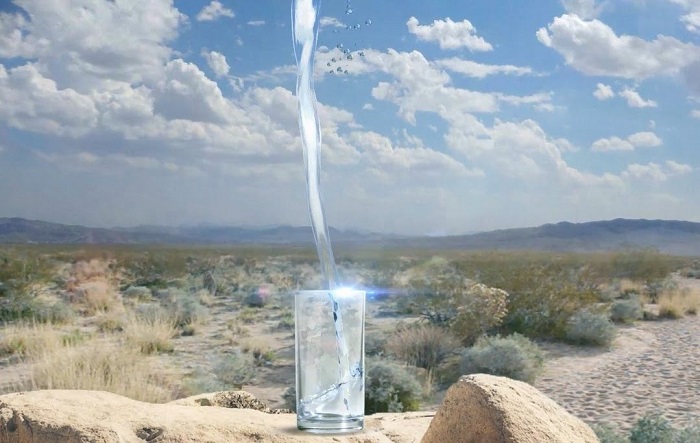nCa Report
Technologies are springing up to pull water from air. There are several new methods that have passed the experimental stage successfully.
For instance, the Khalifa University of the UAE has developed solar-powered water generators that offer a sustainable solution to the Middle East’s lack of rain.
In an article titled ‘Drawing water from desert air no longer a mirage,’ published in The National News on 22 March 2024, Marwa Hassan describes the technology.
The technology, powered by solar panels, efficiently extracts water vapour from the air, promising a significant reduction in the cost and environmental impact of traditional water-sourcing methods.
“With the capacity to produce up to 5,000 litres of water daily, these generators represent a leap towards sustainable water security, aligning with global efforts to find eco-friendly and efficient water solutions,” writes Marwa Hassan.
She toured the project site at the Sas Al Nakhi campus of the Khalifa University and spoke to the project leader, Prof Samuel Mao.
He said the university is in the process of preparing a patent application for its unique implementation of water-generation.
We quote here from her article:
Prof Mao, professor of practice in mechanical engineering and a senior director of the Masdar Institute, said that researchers are looking at ways to bring the cost of implementation down, but there’s ample reason for optimism.
Atmospheric water generators, which allow for moisture to be collected from the air, are used around the world but require an energy source, which negates some of the sustainable goals behind them.
Khalifa University’s solution was to use solar panels to power the pars, creating a net-zero solution that could be used especially in the Middle East and North Africa, where the sun is plentiful.
“The technology involves using solar energy to extract water vapour in the air by cooling the air below its dew point,” Prof Mao said.
He said the smaller implementation of the concept at Khalifa University can produce about 50 litres of water a day, but larger implementations could generate up to 5,000 litres daily, without the pollution and waste of conventional desalination processes.
“Water is generated as long as there is sunshine and moisture in air, and the system does not require electric power from the grid,” Prof Mao said.
The quest for sustainable water solutions has led to various innovative approaches worldwide, including at the Cop28 climate conference in Dubai, where water security and harvesting solutions were a focal point.
There, Manhat, a UAE start-up aiming to build floating farms using proprietary technology to generate fresh water from the ocean without electricity, had a booth displaying its devices.
“We want to bring this technology to market as soon as we can,” said Dr Saeed Alkhazraji, Manhat founder, pointing to the company’s devices.
Recent advancements in technology have shown that harvesting water directly from air is not only possible but increasingly efficient, even in the driest of environments.
UK researchers have developed “Solar2Water,” a system that outperforms conventional AWGs by generating twice the amount of water, regardless of ambient humidity levels.
This technology operates with remarkable efficiency, tapping into solar energy to produce clean water in a sustainable and eco-friendly manner.
Researchers at the Massachusetts Institute of Technology have made significant progress with a solar-powered system capable of extracting drinkable water from air with as low as 20 per cent humidity.
This breakthrough is achieved using a two-stage design that uses zeolite, a widely available adsorbent material, to significantly increase the system’s water output.
Field tests conducted in the arid conditions of Tempe, Arizona, confirmed the system’s potential, marking a substantial step towards providing a sustainable water source for remote, water-scarce regions.
Link to the article of Marwa Hassan at The National
https://www.thenationalnews.com/future/technology/2024/03/22/drawing-water-from-desert-air-no-longer-a-mirage/
A recent paper in Applied Physics Reviews, an AIP Publishing journal, details another innovation by researchers from Shanghai Jiao Tong University in China: a solar-powered atmospheric water harvesting (AWH) system capable of taking water from the air.
This new technology uses special gels that can soak up and release water from the air very effectively. These gels are made from a mix of materials that work together to pull in water from the surrounding environment.
The study’s first author Dr Xiang Chengjie told The National that among all materials that absorb moisture, hygroscopic, or water-attracting, salt is regarded as one of the most effective at drawing in water.
It can capture a lot of water from the air, even when it is not very moist.
While costly, the technology promises competitive drinking water solutions and significant potential for water-stressed regions.
“Although it is not yet possible to solve the problem of low-cost water use in water-stressed regions, we remain optimistic about this technology,” Dr Xiang said. /// nCa, 9 July 2024 [to be continued]
